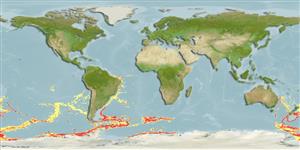Common names from other countries
Classification / Names / Names
俗名 | 同种异名 | Catalog of Fishes (gen., sp.) | ITIS | CoL | WoRMS
Environment: milieu / climate zone / depth range / distribution range
生态学
; 深度上下限 318 - 3000 m (Ref. 2116).
分布
国家 | FAO区域 | 生态系 | 标本纪录 | 简介
Southwest Atlantic, South Pacific and the Antarctic.
Length at first maturity / 大小 / 重量 / 年龄
Maturity: Lm ? range ? - ? cm
Size moderately large, leg span about 82 - 92 mm. Most appendages very long, slender. Trunk and lateral processes well separated, glabrous. Neck of medium length, oviger bases implanted well anterior to first lateral processes, low ocular tubercle placed between oviger bases and first lateral processes. Proboscis rather long, slender, with slight median and distal swelling. Abdomen narrow, short. Xelifore scapes longer than proboscis. Chelae very slender, palms short, fingers very long, overlapping at tips, armed with very many slender sharp teeth. Palps quite slender, third segment about 0.6 length of second, fourth only slightly shorter than fifth (sometimes subequal). Oviger fifth segment longest, slender, distally curved and swollen. Second coxae of legs unusually long, about 4.5 times longer than first coxae. Second tibiae longest segments. Tarsus sometimes shorter, sometimes subequal to propodal length, claw 0.7 length of propodus, sometimes longer, without auxiliaries. Sole of both distal segments with many very short spines (Ref. 9).
Life cycle and mating behavior
成熟度 | 繁殖 | 产卵场 | 卵 | 孕卵数 | 仔鱼
Members of the class Pycnogonida are gonochoric and sexually dimorphic. During copulation, male usually suspends itself beneath the female. Fertilization occurs as the eggs leave the female's ovigers. Males brood the egg masses until they hatch. Life cycle: Eggs hatch into protonymphon larva then to adults.
主要参考文献
参考文献 | 合作者 | 合作者
Child, C.A. 1998. (Ref. 9)
世界自然保护联盟红皮书 (Ref. 130435: Version 2024-1)
Not Evaluated
Not Evaluated
人类利用
| FishSource |
工具
网络资源
Estimates based on models
Preferred temperature
(Ref.
115969): 0.2 - 4.3, mean 2.8 (based on 605 cells).
价格分类
Unknown.
